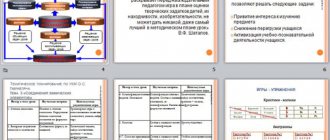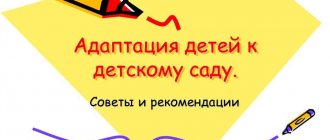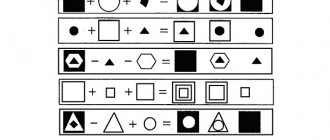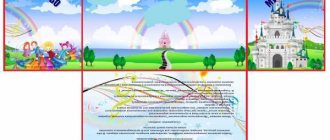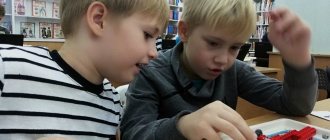Installation of interactive whiteboards in educational institutions
When installing the board, the question arises - where exactly in the classroom it should be located. Although interactive whiteboards are mentioned in SanPiN standards, the rules for placing boards are not worked out and it is not always possible to interpret them unambiguously.
To understand how your interactive whiteboard should be placed, you need to understand the considerations that go into choosing where to install it.
Obviously, both students and the teacher should be able to work directly on the interactive board, and those who are not currently at the board should be able to observe what is happening on it. When working exclusively with high school students and adult students, combining these two requirements is quite simple - when installing the board at such a height that a person of average height can easily reach both the upper and lower edges of the working surface, the entire screen is clearly visible to people sitting in the audience. When When working with young children, combining these requirements is somewhat more difficult.
The second element of the system for which you need to choose a place is the projector.
The diagram below represents the three main types of projectors.
It is quite arbitrary and does not take into account the features of specific models of each type, depending on which the projector can be located at different heights relative to the board, and the distance between the projector and the board varies somewhat. As can be seen from the diagram, when using a standard projector (indicated in the diagram by a red rectangle), the shadow of a person working at the board covers part of the image on the screen, even if a child is working at the board (the shadow area is marked in pink).
When working with a short-throw projector (violet in the diagram), the child no longer sees his shadow on the screen, but for an adult user the difference is not significant (compare the blue and lilac areas). An ultra-short throw projector (green) allows you to get rid of shadows almost completely. The use of the last two types of projectors when working with children is preferable, but when choosing an installation location, you must keep in mind that a projector bar is attached to the wall above the interactive whiteboard, the height of which relative to the board cannot be changed.
Proper selection of a projector ensures comfort when working with the whiteboard, and the exact location of its installation depends on the technical characteristics of the projector and the location of the interactive whiteboard.
Since children must go to the board, it must be easily accessible; it is unacceptable for furniture or additional educational equipment to block access to the board.
In all cases, it is preferable that the equipment is located permanently, on wall/ceiling mounts, and all cables are placed in cable channels - this will ensure both the safety of people and the safety of equipment. When using a board on a mobile stand, it is advisable to use a short-throw or ultra-short-throw projector installed on the same stand and place a laptop/computer next to this complex. This will not only make it easier to set up the system before starting work, but will also minimize the risks associated with loose wires, including power cables, lying on the floor.
How to choose a place to place an interactive whiteboard at school.
The following figure shows a board placed at the height recommended by SanPiN in an elementary school. The part of the board on which it is convenient for a first-grader of average height to complete tasks is highlighted in pale orange. As in the case of a regular chalk board, children sitting in the back desks are somewhat prevented from seeing the bottom of the board by the heads of those sitting in front, but this interference is not critical.
In high school, sometimes there is an additional factor that influences the choice of location for the board. In classrooms of chemistry, physics, biology, etc., there is often a fairly high department in front of the blackboard. It completely covers the bottom of the board from students working in their seats in the classroom. In such classrooms, you can consider placing the board at a higher height, if this does not significantly complicate the teacher’s work (unlike a chalk board, the upper part of which may not be used); in an interactive classroom, it is often necessary to reach the upper edge of the working surface (for example, close the program window ).
SanPin standards also indicate that the board should be located in the center of the classroom, but this standard applies to both chalk and interactive boards, which creates some uncertainty. In cases where a chalk board is primarily used in the office, it is placed in the center, and the interactive whiteboard is to the right or left of it. If the chalk board is rarely used, the interactive board is placed in the center, and the chalk board is placed next to it (or the “wings” of the three-leaf board are on both sides of the interactive board). This norm can also be interpreted in such a way that the group of chalk and interactive boards should be located in the center.
Recommendations for installation in kindergarten.
In preschool institutions, it is better to refuse to use standard projectors when working with an interactive whiteboard - it is quite difficult for a small child to adapt to the fact that his own shadow covers the picture on the board in the place where he was going to draw something or complete a task. It is optimal to use short throw or ultra short throw projectors. Recommendations for installing an interactive whiteboard in a preschool educational institution are not so clear.
The diagram below shows an interactive whiteboard installed at a height as close as possible to “adult” standards.
In this case, it is convenient for the teacher to work with the board; the board hangs high enough so that all children see the entire or almost the entire surface of the board, regardless of how they are seated in the group. But at the same time, children of even older groups will freely reach only a small part of the board (the area marked in pale red in the diagram), which will complicate the development of tasks for children. The following diagram shows a board located at a very low height.
The diagram shows how the space available to a child working at the board has increased, but this placement of the board also has some disadvantages - the teacher will not be able to work at the bottom of the board without bending over; if the height at which the board is installed is reduced, the wall mount will also go lower projector, which does not allow the board to be mounted too low, otherwise the teacher will hit the projector with his head. In a large group, it will be necessary to seat the children so that those sitting in front do not block the view of those sitting behind.
In general, we can conclude that in kindergartens one should not focus on certain “absolute” standards, but choose the height in such a way as to ensure the most comfortable work for both children and teachers.
Application of information and educational resources in preschool educational institutions
Modern technologies for the speech development of preschoolers according to the Federal State Educational Standard include not only book materials, but also electronic educational programs. There is a coherent system in place for teaching preschoolers in various areas.
Education in kindergarten
Preschool educational institutions provide educators and educators with access to electronic educational resources (EER) and multimedia technology. Interactive systems are used to develop speech, memory, imagination, and computer skills.
Additional Information! Various multimedia equipment is actively used at parent meetings and master classes. Kindergarten teachers make presentations that later help in speech therapy and psycho-correctional work with children.
Types of electronic educational resources
Technologies for the speech development of preschool children according to the Federal State Educational Standards programs are developing and expanding every year. A seminar is held for preschool teachers and teachers at which new programs that are acceptable for use in preschool institutions are presented.
Information technology in preschool educational institutions
Rosobrnadzor strictly controls the educational process; a unified educational standard has been introduced that must be followed.
Programs used in kindergartens:
- Electronic kindergarten: document templates, guidelines for teachers, professional development program.
- Website builder "e-Publish".
- Portal "Museums of Russia".
- Website for educators - Preschooler.
- Program "Childhood".
- Online magazine “Kindergarten of the Future”.
Additional Information! In the last year before school, multimedia equipment is used most often in order to prepare the child for entering first grade.
Coloring pages online
The state kindergarten ensures the comprehensive development of children for subsequent entry into school. The senior or preparatory group undergoes various developmental programs on the computer. One of the ways to develop perseverance, attentiveness and a sense of taste is online coloring.
Online coloring services:
- Shading
- Let's play
- Let's play.Pro
To start coloring, you don’t need to register on the sites, you just need to choose the coloring you like.
Children's mazes
Another type of educational game programs for preschool educational institutions are labyrinths. These are small quests in which a child must go from A to Z and save a bird, cat or dog. Such quests develop memory and attention.
Online games for speech development
Links to the best types of games for kindergarten:
- Labyrinth "Bird"
- "Collect toys" or "Help the worm"
- Labyrinths for a car, a knight or a hedgehog
Such games help develop perseverance, attentiveness and memory in preschool children. The DOU uses only a licensed disc or the official website, in order to avoid the presence of extraneous materials on the game page.
Technology of activity teaching method
Important! By playing computer quests, children learn basic skills in using programs. They not only have fun, but also learn how a computer works, how to turn it on and off, and configure it.
Educational children's online games
The preschool period in a child’s life is not the easiest time. The baby must learn to interact with the outside world, operate a computer, think logically and communicate with children and adults.
Educational games:
- games
- games
- games
Additional Information! There are different types of games with which children can develop thinking and logic, learn something about professions, improve memory, mathematical and analytical abilities.
Interactive class
The interactive class of the 21st century “Magic Screen” is a kind of bridge that ensures the continuity of kindergarten and school:
- in preschool educational institutions,
he helps prepare children for entering school; - in primary school
- ensures more comfortable adaptation of children to new forms of learning;
An interactive class, in accordance with the requirements of the Federal State Educational Standard for a developing subject-spatial environment, makes it content-rich, transformable, variable, accessible and safe.
Interactive classroom of the 21st century in preschool and primary schools
can be connected via Wi-Fi to the teacher’s laptop. To the same laptop to which the projector and interactive whiteboard are usually connected. The result is a real interactive class!
At the same time, new, amazing opportunities for classes appear:
- You can monitor the progress of children’s assignments on the teacher’s monitor
- You can help any child directly from the teacher’s computer
- You can run a specific task from the teacher’s computer on all desks in the class
- You can display an image of any of the desks on the interactive whiteboard to continue working on the board
Connecting desks to an interactive whiteboard
can be connected to an interactive whiteboard from any manufacturer. Wherein:
The image of all desks can be displayed simultaneously on the interactive board, and each child will see how successful he is in completing the task compared to the others.
The monitor image of any of the desks can be displayed on the interactive whiteboard in full screen, for joint discussion of options for solving tasks or solving a task directly on the board.
The image from the teacher’s computer can be displayed on the interactive board, and the interactive board will become an additional workplace - for the teacher or another child.
Video about interactive class
Do you have an interactive whiteboard? Just add desks!
If you already have an interactive whiteboard, projector and teacher’s computer, you can use this equipment to connect interactive desks and create a full-fledged interactive classroom.
An interactive classroom is a modular system that can be completed gradually. If you have an interactive whiteboard, buy additional desks, or vice versa, start with purchasing interactive desks, and later buy a laptop, projector and interactive whiteboard.
Your first one will be a joy for children and a useful tool for teachers, speech therapists at preschool educational institutions and schools, and child psychologists.
Don't have an interactive whiteboard? In addition to the desks, purchase:
Organization of joint activities of a child and an adult according to the principles of freedom of choice
- January 19, 2012
Competition “My Pedagogical Initiative - 2011”
Nomination “Methodological work in preschool educational institutions”
The humanization of the goals and principles of pedagogical work with children, the construction of a person-oriented model of interaction between an adult and a child and, at the same time, changes in social life have proven that modern society needs people who can easily adapt to changes in the world around them, make conscious and independent choices, bear responsibility for him. But at this stage, changes in society have led to the fact that the number of people susceptible to some kind of addiction and disoriented in social reality has increased and is constantly growing.
Preschool age is the foundation for the development of a person’s personality, and already during this period the qualities necessary for adaptation to the outside world and for full communication with people begin to be laid.
A child is not born ready for the diversity of life around him, and cannot always make the right choice in favor of one activity or another; he acquires all this while developing in a certain environment and in the process of communicating with an adult. Thus, the most important factor in the development of children's choice is a certain organized environment.
Thus, it is more expedient to begin training such a person already in preschool age. This is largely facilitated by the construction of free activity of children in the second block according to the principles of choice.
Choice is an integral part of a person’s daily life, and such important factors as physical and psychological health, relationships with others, and perhaps life itself very often depend on how correctly it is made.
A characteristic feature of our time is the activation of tolerant tendencies in the upbringing and education of children. The child’s personality with its inherent uniqueness of character and behavior is placed at the center of the educational process.
Preschool age is the foundation for the development of a person’s personality, and already during this period the qualities necessary for socialization in the outside world and for full communication with people begin to be laid.
A child is not born ready for the diversity of life around him, and cannot always make the right choice in favor of one activity or another; he acquires all this while developing in a certain environment and in the process of communicating with adults.
Among the needs of the child that the modern pedagogical process is designed to satisfy, the child’s need for recognition of his achievements by others is very important, since positive personal development is possible subject to positive self-affirmation.
The main task is to form a child’s experience of successful activities, to give him the joy of experiencing his achievements, since the lack of satisfaction with his own achievements, focusing the child’s attention on failures creates significant difficulties for him in establishing positive contacts with people, contributes to the formation of inadequate self-esteem and uncertainty in oneself, indifference to the results of one’s activities.
Thus, the pedagogical process in our kindergarten is aimed at ensuring that every child feels joy from his achievements. This direction in these conditions is determined by the freedom of choice of activity, which presupposes the active subject position of the child in various types of children's activities that are most appropriate to the individual characteristics and interests of the preschooler.
There are a large number of options for organizing choice that can be used with preschool children. We invite you to get acquainted with the most popular and interesting:
- One of them is the “Choice Board”, which is a table with symbols of all types of activities at the top, and cells for children’s chips at the bottom. Children place their chips under the chosen activity.
- Another variation can be considered the following option: all the chips of the children are mixed; whose chip falls out first, he chooses; the children whose chips are dropped last go to the remaining centers.
- The next option: in each center of the group room there is a table where the child’s name, his symbol are written in the left column, and the circles depict the permissible number of visits to this corner for each child. Arriving at the chosen center, the child shades the circle and begins work. When there are no empty circles left, the child can no longer visit this corner and engages in other activities.
In our preschool educational institution, teachers build the educational process taking into account the interests, desires, and needs of children. The team pays great attention to developing effective social adaptation skills in children (the ability to communicate with peers and elders, overcome negative emotional states, etc.), instilling motivation for a healthy lifestyle in children, developing an image of their own body, understanding its beauty and perfection, awareness of the importance of caring for your body.
The position of educators has also changed - the main thing is the development of the child’s personality, helping him to understand the life around him, friendly participation in the events experienced by children, creating social and emotional comfort for the child, an atmosphere of goodwill, interaction and mutual assistance.
Adults create conditions for the development of children’s needs and abilities to:
- self-knowledge (lesson topics “Who am I”, “Know yourself”, “I am ...");
- self-realization (lesson topics “I act”, “I am different”, “I can”);
- self-regulation (lesson topics “Me and my feelings”, “World of emotions”);
- self-determination (“I choose”, “My responsibility”).
We noted that in the process of organizing joint activities of the teacher and children according to the principles of choice:
- the child’s confidence in his abilities is maintained, since he acts as a subject of activity, and adults and peers take him for granted, setting requirements for him in accordance with his age capabilities;
- the child’s responsibility for the results of his activities is formed;
- The child’s arbitrariness of behavior develops, which is manifested in the ability to consciously set goals for action and deliberately seek and find means of achieving them, overcoming difficulties and obstacles.
It should be noted that without certain attitudes in the minds of the teacher it is impossible to achieve a positive result in work.
We use the following operating principles:
- structure the work in such a way as to know why this or that action is necessary for the child, what does it give him?
- Constantly ask yourself questions: “What am I teaching? Can I teach? What do I want to teach? What do I want for each child? What am I doing for this?”
- enter into the image of a child whenever solving difficult situations;
- listen carefully to children, take an interest in every moment of their lives;
- live together and work together;
- create conditions for the child to feel his worth;
- treat each child as an individual, support individuality;
- sincerity in behavior when communicating with children;
- constantly give new impetus to make the child proud of himself;
- build and maintain the child’s self-confidence;
- develop the child’s independence;
- be predictable for the child.
Working according to these principles, we create an atmosphere of psychological comfort for the child: he is surrounded by attention and care, provided with emotionally charged communication with adults and peers.
Thus, a system of complex pedagogical influence is built, in which the child’s personal development and social adaptation are stimulated.
Author: Olga Vasilievna Kharcheva, head of the highest qualification category, kindergarten No. 194 “Kapitoshka”, Tolyatti, 34 years of work experience, awarded Certificates of Honor from the Ministry of Education and Science of the Russian Federation, the Ministry of Industry and Energy of the Russian Federation; laureate of the “Exemplary Kindergarten” and “Best Kindergarten Head” competitions. Liliya Vladimirovna Solovyeva, deputy head for educational and methodological work of the highest qualification category, kindergarten No. 194 “Kapitoshka”, Tolyatti, work experience 12 years; awarded a Certificate of Honor from the Ministry of Education and Science of the Russian Federation, winner of a project competition and a grant from the Tolyatti Foundation for the project “Secrets of the Good Road”.
What to talk about with the teacher and staff?
Do not hesitate to ask the staff how many times a day they do wet cleaning, how often bed linen is changed and whether toys are washed. Get to know the teacher and, if possible, observe the educational process.
A good teacher has an individual approach to each child, he is attentive and tries to understand the student, and knows how to resolve conflicts. At the same time, the teacher should not be too gentle, since the safety of children depends on discipline. In a children's group, it is important to be quite strict, but not rude: the teacher can speak in a commanding tone, but should not shout or break down.
Most parents note that empathy, a personal approach and the ability to find a common language with a child are most important when choosing a teacher.
Informburo.kz survey results
Talk with the teacher about the peculiarities of development and employment: what programs the children study in, whether they correspond to the child’s age, how a day in the garden goes. Your views on these issues should coincide.
Natalia Zakiryanova explains that if you send a young child (up to 3 years old) to kindergarten, then he needs all-round development. At this age, a child does not have to learn foreign languages and the alphabet; what is more important is physical education, speech development, modeling, design, drawing, music, and getting to know the world around him. You can talk about children’s employment not only with the teacher, but also with the kindergarten methodologist .
“Subject-specific developmental environment in a preschool educational institution in accordance with the Federal State Educational Standard for Preschool Education” (consultation for educators)
"Creativity Center"
provides solutions to the problems of activating children's creativity (directing and theatrical performances, musical games and improvisations, artistic, speech and visual activities);
"Game Center"
, ensuring the organization of independent role-playing games;
"Literary Center"
, providing literary development for preschoolers;
"Sports Complex"
, providing physical activity and organizing health-saving activities for children.
There are a number of indicators by which a teacher can assess the quality of the educational subject-play environment created in a group and the degree of its influence on children:
Involvement of all children in active independent activities. Each child chooses an activity of interest in the activity centers, which is ensured by the variety of subject content, the availability of materials, and the convenience of their placement.
Low noise level in the group (the so-called “working noise”), while the teacher’s voice does not dominate the children’s voices, but is nevertheless clearly audible to everyone.
Low conflict between children: they rarely quarrel over games, play space or materials, as they are passionate about interesting activities.
Expressed productivity of children’s independent activities: many drawings, crafts, stories, experiments, play improvisations and other products are created by children throughout the day.
Positive emotional attitude of children, their cheerfulness, openness, desire to attend kindergarten.
Junior group
The environment in the younger group is primarily created as comfortable and safe for the child. Young children do not respond well to spatial changes in their environment; they prefer stability in this regard. In this regard, it is necessary to plan the arrangement of equipment even before the children arrive in kindergarten.
Young children are first and foremost “doers.” The experience of active, varied activities is the most important condition for their development. A child’s stay in kindergarten is organized so that everyone has the opportunity to participate in a variety of activities: games, motor exercises, activities to examine the properties and qualities of objects, drawing, modeling, basic labor, and creative activities. In joint activities with the child, the teacher helps to master new ways and techniques of action, provides a model of behavior and attitude. Taking this into account, the spatial environment is organized for the simultaneous activities of 2-3 children and an adult.
Younger children actively develop movements, including walking, running, and climbing. At the same time, the movements are still poorly coordinated, there is no dexterity, speed of reaction, or evasiveness. Therefore, when organizing the spatial environment, it is advisable to place the equipment around the perimeter of the group, highlighting the play area and a place for household needs, and provide sufficiently wide, clearly visible paths of movement for the child. It is not recommended to include a lot of equipment in the setting; approximately two-thirds of the space should be free.
Take a closer look at the teaching staff
The most important thing in a kindergarten is the people who lead the educational process. “Teachers, teaching staff and, in particular, the director should be focused on the individual psychological characteristics of children and build on the individuality of each individual child,” says child psychologist Alexey Kravchenko.
Child and family psychologist Alina Aleksanyants recommends starting with a conversation with the management of the kindergarten. “To paraphrase the well-known proverb about fish, the kindergarten “blooms” with the manager. This person is often the head, soul and heart of the organization,” says Aleksanyants. Parents, in a conversation with the manager, must find a response and understanding, and the meanings and values that are transmitted by the management of the kindergarten must coincide with their expectations, the psychologist emphasizes.
According to Kravchenko, specialized specialists should also work in the kindergarten: a child psychologist, a speech therapist and a defectologist. “A psychologist can diagnose a child, understand the characteristics of his development and identify whether he has medical problems related to the psyche - it is advisable that the specialist has a qualification in clinical psychology,” explains the expert. A defectologist can implement the program prescribed by a psychologist. And a speech therapist will be able to give the child good speech, which is necessary for the development of his personality and thinking, concludes Kravchenko.
